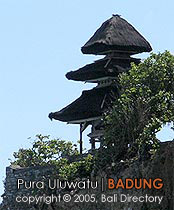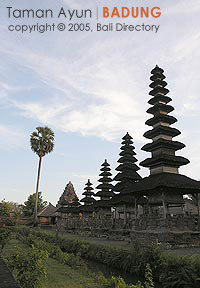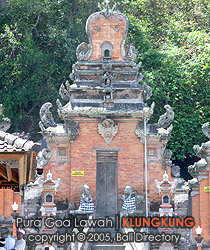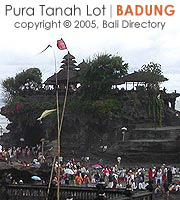|
 |
| Home
> All About
Bali > Temples |
| |
| Temples |
| |
 |
| |
|
| |
Bali is known as an island of thousands
temples. In every village in Bali, there are several
temples and at least one small temple in each home
of Balinese which reach to a total of 10.000.
Balinese word for temple is ‘pura’
which means 'space surrounded
by a wall'. Although many temples are quiet
and uninhabited, they are transformed into colorful,
active and decorated places of worship when there
is a festival. While offerings are made, performances
of traditional dances and gamelan, cockfighting
and gambling enliven the atmosphere.
All temples derive their direction from the mountains
and the sea. The direction toward the mountains,
Kaja, is the most significant direction. The direction
toward the sea is Kelod. The direction toward the
sunrise, Kangin, is found in most secondary shrines.
There are three fundamental types of temple in every
village. Pura Puseh (temple
of origin) remains the most important and
is reserved for founders of villages. It is always
situated at the kaja end of the village.
In the middle of the village is the Pura Desa, which
is for the spirits that protect and bless the villagers
in their daily lives.
At the kelod end of the village is the Pura Dalem
(temple of the dead)
as well as the graveyard. The Pura Dalem would have
representations of Durga, the dark and terrible
side of Shiva's wife, Parvati. Both Shiva and Parvati
have a creative and destructive side, and it is
their powers of destruction that are honored in
the Pura Dalem. |
| |
| Uluwatu
Temple |
 Located
at the western most tip of Bukit Peninsula, this
temple is one of Bali's Kayangan Jagat Temples.
Its location is dramatic, perched on the edge of
a high cliff with a picturesque sunset view. The
temple is carved from the enormous limestone rock.
‘Ulu’ means
head, ‘watu’
means rock, and ‘Luhur’
implies heavenly, ancestral, original and transcendent
all at once. Located
at the western most tip of Bukit Peninsula, this
temple is one of Bali's Kayangan Jagat Temples.
Its location is dramatic, perched on the edge of
a high cliff with a picturesque sunset view. The
temple is carved from the enormous limestone rock.
‘Ulu’ means
head, ‘watu’
means rock, and ‘Luhur’
implies heavenly, ancestral, original and transcendent
all at once.
Uluwatu Temple was first used for worship by the
holy 11th century
priest, Empu Kuturan, who came to Bali to convey
religious law and to form Desa Adat (traditional
villages).
This temple was then used for worship by the next
holy priest, Dang Hyang Nirartha, who came to Bali
at the end of 1550 and ended his holy voyage in
this area. |
| |
| Sadha Kapal
Temple |
This temple is famous for its detailed
and beautiful decorative carving. Dating from Majapahit
period, it originally was an old dynasty sanctuary
(prasada) of Ratu Jayengrat,
a noble, who sailed from Majapahit and stranded
on the coral reef at Kapal Village.
This temple was destructive by earthquake in 1917
and has not been restored until 1950. The split
gate and a 16meter high tower inside the temple
are constructed much like ‘candi’
(temple) in Java. The
64 stone seats, similar to megalithic shrines, memorialize
warriors who died in battle. |
| |
| Taman Ayun
Temple |

Taman Ayun which means beautiful garden, is located
in Mengwi Village, 18 km northwest of Denpasar.
It was built in 1634 by I Gusti Agung Anom, a founder
of the Mengwi Kingdom, and became the main temple
for the ancient Mengwi Kingdom. The temple is surrounded
by ponds which give the effect from a distance as
if the temple is floating on water.
Taman Ayun Temple was renovated in 1937. The grassy
area of the outermost courtyard, the fine array
of roofs (merus) and
pavilions in the inner courtyard, and its well-kept
appearance make it one of the most beautiful temples
in Bali.
The temple complex consists of three ground areas.
In the outermost court is Bale Wantilan which is
used for all events, religious ceremonies, dance
performances or cock fighting. To the west, there
is a decorative fountain called Padma Sana. In the
innermost court, surrounded by a small pond, there
are 29 buildings which function as places for the
gods and goddesses, called Bale Pelik with beautiful
carvings, interesting relics and statues of the
nine gods, Dewa Nawa Sanga. The whole complex of
temple symbolizes the great Mandhara Mountain turning
in a sea of milk. |
| |
| Kehen Temple |
Kehen Temple, one of ancient temples
in Bali, is located at the south of Bangli in Cempaga
village, about 43km from Denpasar. It was built
by Sri Bhatara Guru Adikunti Ketana who reigned
Bangli kingdom in the 12th
century in a terraced mountain sanctuary. The people
of Bangli believe that Kehen Temple is the largest
and the most sacred temple of the region and regard
it as the state temple of Bangli.
This temple is worshipped by people around the village.
The ceremony takes place on Rabu Kliwon Shinta where
Ngusaba ritual is held one in a three years period,
which is on fifth Purnama around November.
Kehen Temple offers an authentic Balinese temple
atmosphere. It has three courtyards connected by
steps, and is decorated with carvings and statues.
In the first courtyard is a huge Banyan tree, surrounded
by walls inlaid with Chinese porcelain. In the next
courtyard, multi-roofed shrines (merus)
dominate the area. On the right side of this inner
courtyard are three throne shrines representing
the Hindu Trinity, Brahma, Wisnu and Siwa.
Besides its magnificent panorama, Kehen Temple has
a variety of ancient manuscripts. There is a manuscript
about the slaughter of a black bull during a feast
held in the temple in the year 1204.
At the foot of the stairway is an old temple, which
has a collection of historical manuscripts inscribed
on bronze plates. Statues, carved in a shadow puppet
style, line the first terrace from which steps lead
to the most important gate (the
Great Exit). Like other split gates found
in all Balinese temples, above the gate looms the
hideous face and splayed hands of Kala Makara. This
terrifying creature symbolizes the demonic one who
catches harmful spirits and prevents them from entering
the sacred space. On the other side of this area
is a statue of a villager gesturing a welcome to
visitors. |
| |
| Pancering
Jagat Temple |
Pancering Jagat Temple is located
in Trunyan village, Kintamani. The temple’s
name is taken from Arca da Tonta or Ratu Gede Pusering
Jagat, a megalithic 4-meter high statue. The ceremony
in this temple is usually held on Purnamaning Sasih
Kapat around October.
Barong Brutuk dance is performed on the ceremony
to commemorate the legendary wedding anniversary
of Ratu Sakti Pancering Jagat; the guardian of the
village and Ratu Ayu Dalem Pingit (Ratu
Ayu Dalem Dasar). This dance can only be
performed by adolescent boys (Sekeha
Teruna) of that village. The boys, together
with the village elders, must fulfill certain requirements
such as be successful in holiness ceremony for 42
days in Pancering Jagat Temple with certain offerings.
|
| |
| Penulisan
Temple |
Bukit Penulisan (Penulisan
hill) is located at 1745m above sea level,
approximately 3km from Kintamani, or 30km from the
capital city of Bangli. Bukit Penulisan is also
called Bukit Tunggal because its site is separated
from mountain range stretches along from west to
east of Bali.
Around 9th century,
Tegeh Koripan Temple was built on Bukit Penulisan.
It is also known as Puncak Penulisan Temple since
it is located on the peak of Bukit Penulisan.
An old stairway leads to Puncak Penulisan Temple,
the ancient temple as well as the highest temple
in the island. During a clear day, the view is breathtaking.
The temple is even more romantic and mysterious
when covered in a foggy mist. |
| |
| Pulaki Temple |
Pulaki Temple is located in Bayupoh
Village, about 53km west of Singaraja. It is situated
on a hill that is about 25m from the beach. This
temple is inhabited by monkeys which are considered
as the descendants of Dewa (Gods).
Pulaki Temple is one of the Sad Kahyangan Temples
(the main temples)
in Bali. There are also Pabena Temple and Pemuteran
Temple which is well-known for its hot water nearby.
|
| |
| Meduwe Karang
Temple |
Meduwe Karang Temple is located
in Kubutambahan Village, 12km east of Singaraja.
This temple is a place to pray for the plantation
to be fruitful.
The stairs are guiding the visitors to the big area
of the temple. In front of the temple there are
rows of statues telling the story of Ramayana. The
inner part of the temple is the most sacred for
Hinduism people. It is decorated with carvings reflecting
the nobleness and the daily life. |
| |
| Rambut
Siwi Temple |
Rambut Siwi Temple is located on
the top of a cliff, overlooking a breathtaking view
of paddy fields on one side and the black sandy
beach on the other.
This spot is a favorite hangout for painters. The
temple itself was built by Dang Hyang Nirartha.
Legend has it that he dedicated his hair to the
temple. Therefore, the temple is known as Rambut
Siwi which literally means ‘hair
worship’. |
| |
| Besakih
Temple |
Besakih Temple, over 900 meters
up the slopes of Mount Agung, is the largest and
most sacred Hindu temples in the island. It is named
after Naga Besukian, the dragon god thought by pre-Hindu
Balinese to inhabit Mount Agung, the highest mountain
in Bali. Besakih Temple has been regarded as a central,
holy temple for the entire island since the Gelgel
Dynasty of the 15th
century. Today, it is referred by all Balinese as
the mother temple of Bali.
Over a thousand years and more, Besakih Temple was
extended to the present complex of about 30 temples.
There are three main temples within Besakih Temple;
Pura Penataran Agung, dedicated to Sang Hyang Widi
Wasa. Inside the main courtyard stands the three-seated
shrine enthroning the Trisakti, the trinity of Brahma,
Visnu and Siwa. During festivals the shrines are
wrapped in colored cloth symbolic of the deities.
The other two main temples are Pura Kiduling Kreteg,
dedicated to Brahma; and Pura Batu Madeg, dedicated
to Wisnu.
For Balinese people, a visit to the temple sanctuaries
at Besakih is a special pilgrimage. Each temple
has its own anniversary ceremony (Odalan)
and on the full moon (Kedasa)
the entire compound of Besakih commemorates the
visit of the gods with an enormous mass of visiting
pilgrims. |
| |
| Goa Lawah
(Bat Cave Temple) |
Goa Lawah is one of the most sacred
temples in Bali, built by the high priest ‘Empu
Kuturan’ in 11th
century. The center of the temple is built around
a natural cave inhabited by thousands of bats hanging
down and flying around, as well as holy python snakes.
Legend has it that this cave is a dwelling place
of Naga Basuki, the mythical and sacred dragon of
the Mount Agung as well as the guardian of Besakih
temple.
This temple is located in Wates village, on the
southeast coast of Bali, west of Candidasa, approximately
50km east of Denpasar. It is considered as one of
the important temples in the island. Balinese people
come to this temple with offerings to complete a
cremation ceremony, called Nyegara Gunung ceremony.
 This
temple was used as a place of worship by the King
of Klungkung in the 17th
century. Goa Lawah was also used to test the people
who found guilty of breaking the law. This
temple was used as a place of worship by the King
of Klungkung in the 17th
century. Goa Lawah was also used to test the people
who found guilty of breaking the law.
Around the 17th
century, a dispute happened between the King of
Mengwi's sons, I Gusti Ngurah Made Agung and I Gusti
Ketut Agung. I Gusti Ketut Agung was not accepted
as the descendant of the King of Mengwi. He was
sent to be tested by the King of Klungkung who was
respected as the highest king. The King of Klungkung
asked I Gusti Ketut Agung to enter Goa Lawah. If
he came out alive he would be acknowledged as a
descendant. I Gusti Ketut Agung accepted the sentence,
entered the cave and finally came out in Besakih.
Based on the King of Klungkung’s decision,
he then was acknowledged as a part of the King of
Mengwi's family. He was known as I Gusti Ketut Agung
Besakih when he became a king. It is said that he
became deaf because of entering the cave. |
| |
| Luhur Batukaru
Temple |
Luhur Watukaru Temple is located
in Wangaya Gede village, approximately 21 km northwest
of Tabanan. This temple is one of six sacred temples
(Sad Kahyangan) in
Bali.
The temple is surrounded by thick foliage and refreshing
fresh air. There are old Balinese remains in this
temple. Numerous local and foreign visitors visit
this temple, especially on its temple festival,
which is usually held on Umanis Galungan, one day
after Galungan. |
| |
| Batur Temple
(Ulun Danu Batur Temple) |
Batur Temple, also known as Ulun
Danu Batur Temple, is located in Kalanganyar, Batur
village, Kintamani, approximately 900 meters above
sea level. It is also known as the Temple of the
Crater Lake, dedicated to the Lake Goddess Ida Batara
Dewi Ulun Danu, and Tirta Empul, where run the holiest
waters of Bali, believed to have magical curative
powers.
Batur Temple is the second largest temple in the
island. Huge ceremony, called Ngusaba ke Dasa, is
held here every year.In the past, Batur Temple was
located on the south western slope of mount Batur.
After the destructive eruption in 1917 which ruined
the temple. Head of the village along with the villagers
brought the surviving shrines and rebuilt Batur
Temple to the higher place in Kalanganyar.
In 1927, the people of Batur rebuilt Ulun Danu Temple
which once lay at the foot of the volcano. Most
of the 285 planned shrines are yet to be completed.
At present, the temple is simply designed. |
| |
 |
| |
| Tanah Lot
Temple |
Tanah Lot, located on the west coast
of Bali, in Beraban village in Tabanan regency,
is one of the most popular sites in Bali. Tanah
Lot means the ancient land as well as the land to
the south.
This temple was built in the 15th
century by the priest Pedanda Bahu Rawuh or Danghyang
Nirartha from Majapahit Kingdom. During his voyage
along the south coast he caught sight of a rock
island and rested there. Some fishermen noticed
him and invited him to stay at their hut. Nirartha
refused, saying he preferred to spend the night
on the little island. That evening, he talked to
the fishermen and advised them to build a shrine
on the rock. Nirartha felt it would be a holy and
appropriate place to worship God.
Built on a small cape, Tanah Lot is only accessible
at low tide. During high tide, the rock appears
as a large ship at sea. There are several small
and big shrines nearby, the biggest one is Pekendungan
Temple. There is a spring considered sacred not
far from this temple.
 Poisonous
snakes inhabit the nearby caves as the guardian
of the temple. The perfect time to visit Tanah Lot
is at the sunset when the golden red sky surrounds
the temple and the wave crashes into the rocks. Poisonous
snakes inhabit the nearby caves as the guardian
of the temple. The perfect time to visit Tanah Lot
is at the sunset when the golden red sky surrounds
the temple and the wave crashes into the rocks.
Though Tanah Lot is a small sanctuary, it is related
to several sea temples on the south coast of Bali:
Pura Sakenan, Pura Uluwatu, Pura Rambut Siwi and
Pura Petitenget. All these temples are related to
the primary mountain sanctuaries: Besakih at Mount
Agung, Pura Batur at Batur and Pura Luhur at Mount
Batukaru. |
| |
| Jagatnatha
Temple |
Jagadnatha Temple is located in
Denpasar, on the north side of Museum Bali and the
east side of Puputan Square. It is built towards
the west as any other temples in Bali.
This temple is built as the result of Parisada Dharma
Hindu Bali’s convention on November 20, 1961
in Campuhan, Ubud, Gianyar. One of decisions is
to establish the center of religious educational
activity to intensify the Hindu religion in Bali
especially and Indonesia generally.
Every fifteen days, on the full moon and on the
dark moon, this temple is full of Hindu's people
coming to pray which most of them are from Denpasar.
Sometimes, after the praying ceremony, the shadow
puppet show (Wayang)
is held in the afternoon and the evening beside
this temple. |
| |
| Makori Temple |
| Makori Temple is located in Blimbing
village, 55km from Denpasar or 32km from Tabanan.
This temple consists of many stones hidden in the
forest. It does not similar to other temple in Bali,
but it is a place where people pray to their God. |
| |
| Tampak
Siring |
Tirta Empul Temple is built at Tampak
Siring around the sacred spring which is believed
to have magical curative powers. It is said that
the God Indra created the spring when he pierced
the earth to build the Amerta, the elixir of immortality,
with which he revived his forces whom were poisoned
by Mayadanawa.
Over 1000 years old, the temple and its two bathing
places have been used by the people for good health
and prosperity because of the spring water's healing
powers. Regular ceremonies are held for purification,
especially pregnant women and those who have endured
a long sickness. On the full moon of the fourth
month each year, the villagers from nearby Manukaya
take a sacred stone to be cleansed at Tirta Empul.
On the hill above the sacred spring is the Government
Palace, built in 1954 which was once a resting home
for Dutch officials. It was also the former President
Soekarno’s residence during his frequent trips
to the island.
On the south of Tirta Empul, near Mount Kawi, there
is Mengening Temple. There is a relation between
these three places. Mengening Temple also has a
spring of pure water. It is considered as the memorial
temple of King Udayana. |
| |
| Sakenan
Temple |
Sakenan Temple is built in the 13th
century by a holy priest ‘Dang Hyang Dwijendra’
on a small island called Serangan Island near Benoa
Harbour and Nusa Dua.
This temple is divided into two parts. Inside the
first part, there is a shrine of Cri Cedana or Dewi
Sri, the goddess of prosperity and welfare. In the
second part of Sakenan Temple, there are shrines
for the Prasanak, the relatives of Dewi Sri who
come to visit the temple on its anniversary day.
On the holy day of Manis Kuningan, Sakenan Temple
commemorates the anniversary of its founder Mpu
Kuturan. The festival is held in two days which
begins on the last day of Kuningan Wuku and ends
on the first day of Langkir Wuku. |
| |
| Maospahit
Temple |
| Maospahit Temple was built around
14th century.
It was restored following a large earthquake in
1917. It is associated with Majapahit Kingdom as
parts of this ancient temple imitated from Majapahit
Kingdom. |
| Some relics of the Maospahit
Temple: |
| • |
Gedong has two Arca
Terracota which put at right left entrance. |
| • |
Gedong Kemimitan has
one Arca Terracota Pergina and one fragment
Arca Terracota. |
| • |
Candi Bentar has relic
of Garuda on the left side and relic
of Bima on the right side. |
|
|
| Maospahit Temple used to be a kingdom
temple when Badung kingdom was still the authority.
Nowadays, there are 20 families who take care the
temple and its ceremony. |
| |
| Petilan
Pengrebongan Temple |
Petilan Pengerebongan Temple is
located at Kesiman Petilan Village, East Denpasar.
This temple is one of Dang Kahyangan and is well-known
for its Ngerebong ceremony. Petilan Pengerebongan
Temple consists of two parts: Jeroan temple and
Jaba temple. It is in wantilan hall of Jaba temple,
Ngerebong ceremony takes place.
Ngerebong ceremony is a religious ceremony which
involves a large number of barongs and rangdas.
Along with a large number of people who become in
trance, they encircle the wantilan hall three times
in a long procession. |
| |
|
 |
|
|
